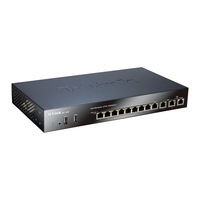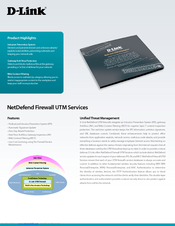User Manuals: D-Link DFL-860-WCF-12 Content Filtering
Manuals and User Guides for D-Link DFL-860-WCF-12 Content Filtering. We have 2 D-Link DFL-860-WCF-12 Content Filtering manuals available for free PDF download: User Manual, Datasheet
D-Link DFL-860-WCF-12 User Manual (552 pages)
Network Security Firewall NetDefendOS Version 2.27.03
Table of Contents
-
Preface14
-
-
-
Overview28
-
The CLI34
-
CLI Scripts43
-
Secure Copy46
-
-
-
Overview62
-
-
Maintenance75
-
-
-
Services85
-
Interfaces93
-
Overview93
-
Enabling Dhcp100
-
Vlan101
-
-
VLAN Connections103
-
Defining a VLAN104
-
Pppoe105
-
GRE Tunnels107
-
Interface Groups111
-
-
Arp112
-
-
-
IP Rule Actions125
-
Schedules131
-
Certificates133
-
Date and Time137
-
Overview137
-
Enabling DST138
-
Time Servers138
-
-
Dns144
-
4 Routing
147-
Overview147
-
Static Routing148
-
-
Setting up RLB174
-
Ospf176
-
Dynamic Routing176
-
-
-
-
OSPF Components184
-
-
-
Setting up OSPF193
-
An OSPF Example196
-
Add an OSPF Area197
-
-
-
5 DHCP Services
228-
Overview228
-
DHCP Servers229
-
-
Custom Options233
-
DHCP Relaying235
-
IP Pools238
-
-
-
-
Access Rules242
-
Overview242
-
IP Spoofing243
-
-
Algs245
-
Overview245
-
-
Deploying an ALG245
-
The HTTP ALG246
-
-
-
The FTP ALG249
-
-
-
The POP3 ALG268
-
The PPTP ALG269
-
-
PPTP ALG Usage269
-
The SIP ALG270
-
The H.323 ALG280
-
The TLS ALG294
-
-
TLS Termination295
-
-
-
IDP Rules322
-
-
-
IDP Actions327
-
-
Overview332
-
The Jolt2 Attack335
-
-
-
Overview340
-
Nat341
-
A NAT Example343
-
-
NAT Pools346
-
Using NAT Pools347
-
Sat349
-
-
-
-
Port Translation356
-
-
-
-
Overview361
-
-
Setup Summary363
-
-
-
9 Vpn
383-
Overview383
-
VPN Usage383
-
VPN Encryption384
-
VPN Planning384
-
Key Distribution385
-
-
VPN Quick Start387
-
Ipsec Components397
-
Overview397
-
NAT Traversal405
-
-
The AH Protocol405
-
The ESP Protocol405
-
Pre-Shared Keys408
-
Ipsec Tunnels412
-
Overview412
-
Roaming Clients414
-
-
Pptp/L2Tp431
-
-
CA Server Access440
-
-
-
-
Traffic Shaping451
-
-
Pipe Groups462
-
-
-
Logging476
-
Threshold Rules477
-
-
Overview480
-
-
-
-
Overview489
-
HA Mechanisms491
-
Setting up HA494
-
HA Issues498
-
-
12 Zonedefense
504 -
-
State Settings521
Advertisement
D-Link DFL-860-WCF-12 Datasheet (5 pages)
NetDefend Firewall UTM Services
Advertisement

